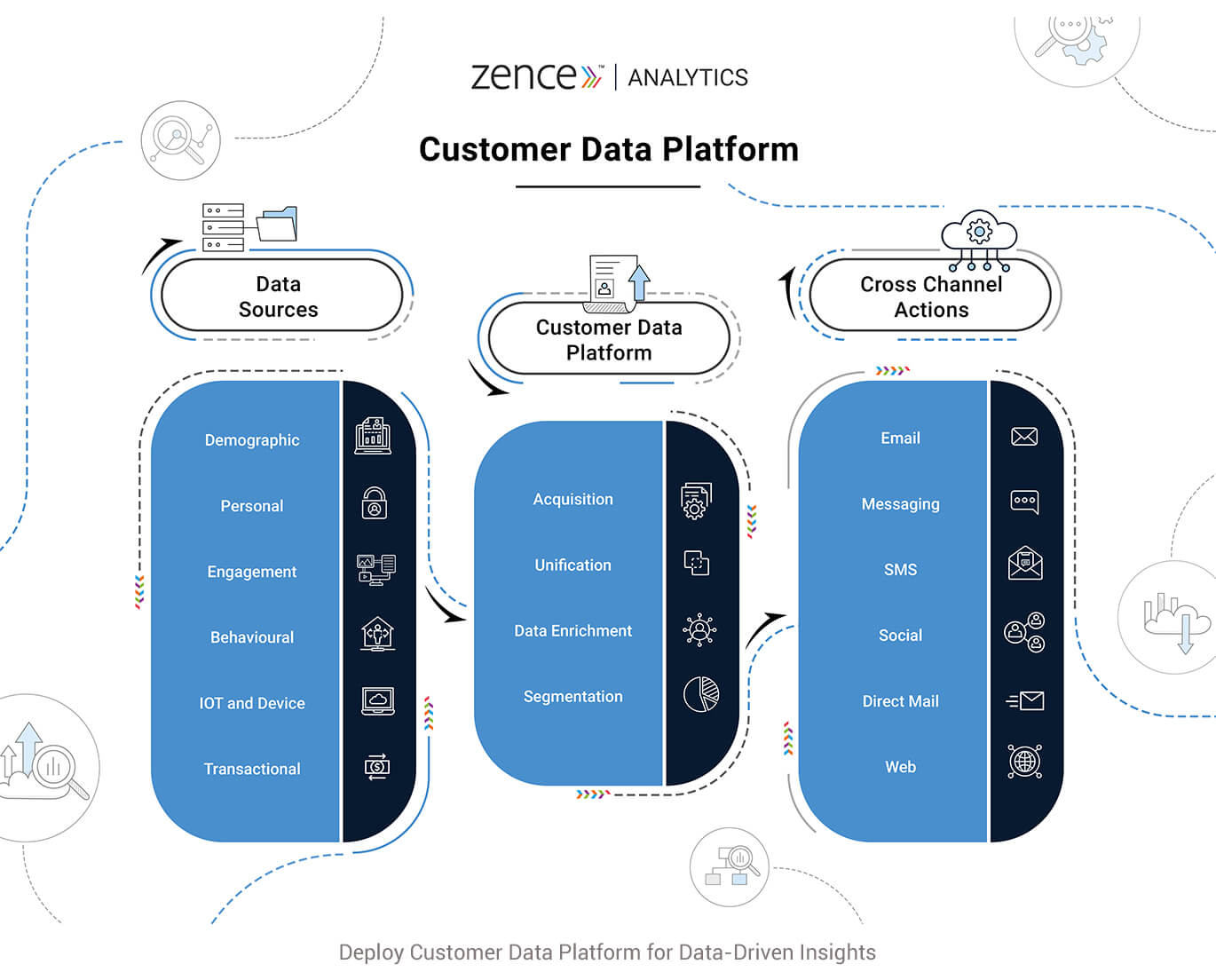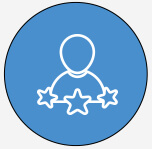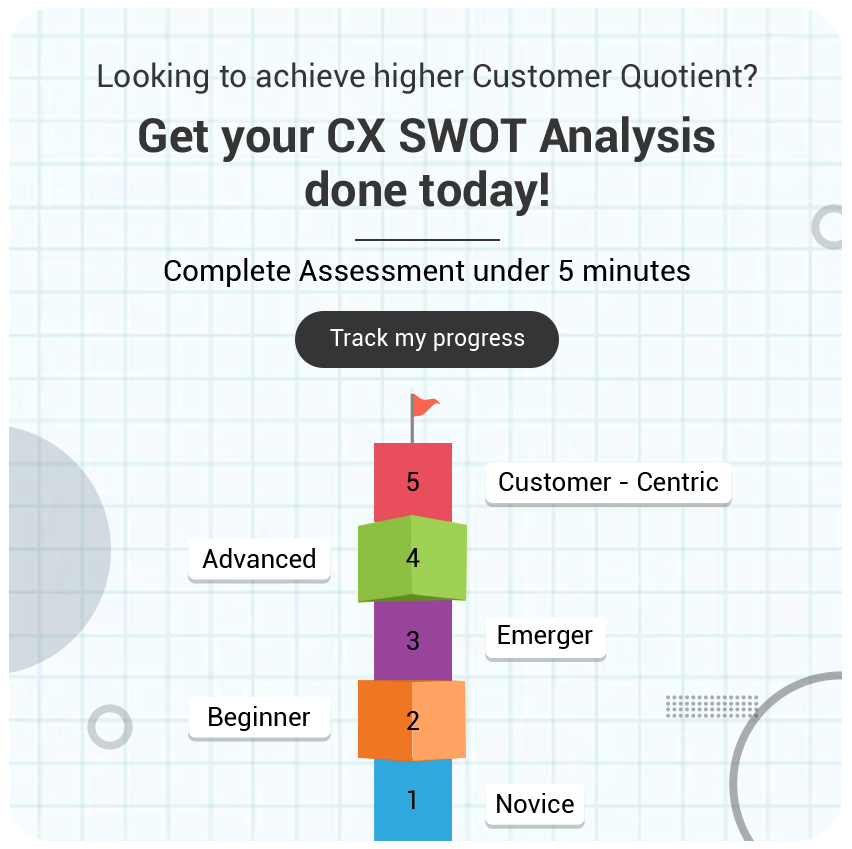Strike the Right Chord at the Right Time with
Customer Data Platform
Customer Data Platform: Delivering the Right Engagement, to the Right Customer, at the Right Time
Modern marketing is driven by data. However, even in this age of data-driven economies – where almost 60% of the world population is connected online – businesses often lose the data that is generated by their websites, mobile apps, and other digital channels.
How can this problem be stemmed? By deploying efficient tools that capture consumer data across touchpoints (that otherwise exist in disparate technology silos) and transform it into intelligent, actionable insights.
Enter : Customer Data Platforms
A technology that comes with a distinct advantage over other legacy systems and boosts marketing efficiency.
It is no surprise that CDPs are gaining growing traction across industries. This cutting-edge technology powers comprehensive data-driven marketing. It connects to a wide range of systems and data sources across enterprises and ingests all types of data – be it real-time interaction data, campaign data, product data, customer support data, device, or IoT data.
The sheer depth of data that CDPs can process has propelled it from a `good-to-have’ to a `must-have’ technology for enterprises. By using, managing, and analyzing data, CDPs help marketers build smart campaigns.
There are some compelling reasons why AI-powered Customer Data Platforms like Easyrewardz Zence have metamorphosed into a marketer’s favorite:
It’s a hub of customer data. It consolidates customer data and stitches it into unified customer profiles. The CDP sits at the center of an enterprise’s data ecosystem, connecting all the channels, platforms, and products that a customer uses.
It provides a Single View of Customer. The CDP captures all customer actions, across touchpoints, syncs the information, and attributes the right actions to the right customer.
It stores, connects, and unifies customer data, giving marketers a holistic view of their customers – irrespective of the different devices they use or marketing channels they interact with.
It makes data actionable for marketers. With consolidated data at hand, Zence helps marketers derive insights from it, to deliver unified, personalized, omnichannel experiences to their customers.

In this article, we will dive into the CDP success story to understand why it’s become the CRM tool to watch out for, why businesses need a CDP, and how the platform stands out from other tools in the same space.
Decoding the CDP mania
There have been some recent and defining global developments that got more and more businesses to gravitate towards adopting a Customer Data Platform to collate and comprehend customer data. Here are the most outstanding events:
Rapid digital transformation in a post-Covid world: Ever since the world went into lockdown, and people turned to online shopping, digital channels have made an undisputed mark for themselves in the marketing mix. This, in turn, has accelerated the need to manage customer interactions across digital channels.
End of the third-party cookie era: In the coming future, browsers will no longer be supporting third-party cookies. This means the cookie-based targeting route on ad platforms is going to turn redundant. Marketers will now have to depend on first-party data to know their customers better – and CDPs enable tracking and storing user information using first-party cookies.
Growing need for smart customer interactions: Brands are increasingly looking at onboarding the power of AI and machine learning in order to know their customer better and to personalize interactions. AI-driven tools like CDPs help enterprises record every customer interaction, join the dots across touchpoints and use the insights to create meaningful interventions.
Types of customer data – and why businesses need the RIGHT data
Modern enterprises run on the power of customer data. However, the data that marketers have access to is often irrelevant, incomplete, and siloed.
This is where the CDP stands out as an out-of-the-box solution – because it does more than just collecting data. CDPs collect the right kind of data. As the world of digital marketing and online shopping witnesses a boom in channels and data types, marketers are facing an outpouring of customer data. Everything from ad impressions, and product usage, to customer service interactions, have turned into data collection hubs.
And there are some main types of customer data that are sourced from here
- Behavioral data: Obtained from a customer’s interactions with a brand across touchpoints. It includes website
visits, apps downloaded, games, social media engagement, and the number of devices used. - Qualitative data: Takes into account a customer’s product preferences and other markers like customer service
rating. - Demographic or Identity data: This includes information like age, gender, nationality, education, hobbies and
interest, profession and employment, name, date of birth, and contact details. - Transactional data: Broadly covers transactions such as purchases, returns, payments, signups, reservations,
and subscriptions. - Device level data: This information ranges from cookie IDs, device IDs to IP addresses.

With so much data available, why do marketers face information-related challenges?
As the data is siloed it makes it difficult for enterprises to get a detailed view into their customers, they likes and dislikes. And when these precise data-driven insights are not at the marketer’s fingertips, decision-making becomes difficult and ineffective.
For customer data to be effective, it has to be taken out of siloed systems, so that marketers have easy access to the information and can get a unified and enriched view of their users. The CDP does this in a quick and seamless manner, as its core functionality is to analyze data flowing in from multiple sources, provide a 360-degree view of each user, and top it with insights and recommendations.
How do CDPs collect and collate the massive amounts of customer data that flows into an enterprise? It’s a four-step process:
- Data Acquisition: The CDP integrates all the data sources into one place
- Unification: All user data is collated at a single source to provide a unified view of customer actions
- Data Enrichment: Build reports and dashboards to view customer’s actions, as well as marketing campaigns and goals
- Data Activation: All the information is processed in one place and used to activate and mobilize data that can be used to create precise and personalized marketing campaigns
Modern enterprises need a Unified, Comprehensive view of their Customers
As purchase journeys turn digital and marketers raise the bar for creating compelling customer experiences, global companies are onboarding CDPs to meet rising user expectations. Here are some reasons why enterprises are onboarding tools that provide them with a unified, comprehensive, and single window view of their customers.
Brands are focusing on knowing their customers
E-commerce makes up 42% of all B2B purchases today. By 2023, it is expected to reach 58% of total retail sales in the US. That’s a huge number, and companies are rolling out the red carpet to woo online shoppers. To stay competitive, they are creating personalized experiences throughout the customer lifecycle by converting user data into insights – at speed. CDPs are making the cut as the technology of choice, as they help increase an understanding of the customer journey, personalize experiences, and improve user satisfaction.
Building seamless customer experiences has become the cornerstone of business success
Tools that offer seamless customer data management and analytics help enterprises address their business priorities better by creating fulfilling user experiences.
3 main reasons why companies invest in CDPs

Improve customer
satisfaction

Personalize user
experiences

